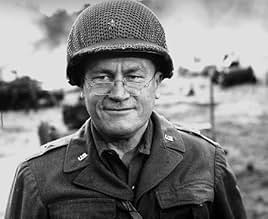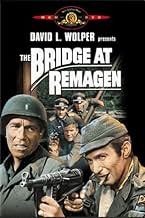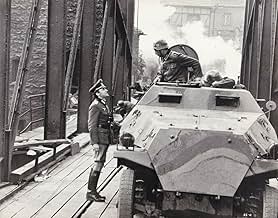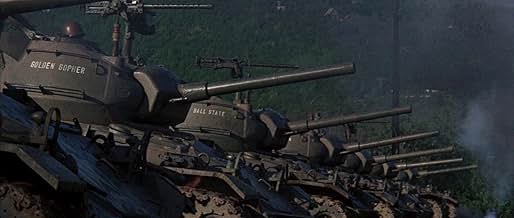IMDb रेटिंग
6.7/10
11 हज़ार
आपकी रेटिंग
अपनी भाषा में प्लॉट जोड़ेंAs the Allied armies close in, the Germans decide to blow up the last Rhine bridge, trapping their own men on the wrong side. But will it happen?As the Allied armies close in, the Germans decide to blow up the last Rhine bridge, trapping their own men on the wrong side. But will it happen?As the Allied armies close in, the Germans decide to blow up the last Rhine bridge, trapping their own men on the wrong side. But will it happen?
- निर्देशक
- लेखक
- स्टार
Peter van Eyck
- Gen. Von Brock
- (as Peter Van Eyck)
Anna Gaël
- French Girl
- (as Anna Gael)
Vít Olmer
- Lt. Zimring
- (as Vit Olmer)
फ़ीचर्ड समीक्षाएं
Famous for its Apocalypse Now-style production problems. Filmed in then-Czechoslovakia where the then Communist government offered up a whole town (due to be cleared to make way for a strip mine) for cinematic destruction. But halfway through shooting the Russian army invaded to remove reformist president Alexander Dubcek. George Segal and Robert Vaughn give career best performances, but it also marks the moment when US war films moved beyond action-adventure and into a darker realm. The capture of the Remagen Bridge in 1945 was a magnificent feat of arms by the US Army. But in the film account the troops are slovenly, often fearful thugs, slanging and striking their officers, robbing corpses and killing children. It's not really about World War II at all, but about how many Americans saw the Vietnam War. The Bridge at Remagen is out of time, set in 1945 but made in 1968, the year of the Tet Offensive, when the US realised that Vietnam was a lost war. It shows.
American director John Guillermin, known for several epic "clunkers", pulls together this rather tense look at one of the most important battles of World War II: American forces clash with the Germans at Remagen, where the last intact bridge over the Rhine stands between the two opposing forces.
The script divides attention evenly and fairly between the two forces. George Segal ("The Longest Day") is Lt. Hartman, a burned out and pretty tired junior officer who doesn't want to accept the responsibilities of command when his company commander is killed. The war is almost over, and Hartman is concerned with getting his men home. On the other side of the river, German Major Kreuger (Robert Vaughn) is equally concerned with saving lives German lives. He becomes obsessed with keeping the bridge intact in order to allow retreating German soldiers to attack, despite orders from the High Command to blow up the bridge to prevent its' capture by the Allies.
The supporting cast is filled with fine performances. The standouts are Hans Christian Blech ("Battle of the Bulge") as Captain Schmidt, a weary Wehrmacht Officer who feels his duty is to protect the civilians whom Kreuger puts in harm's way by continuing a hopeless fight. Blech's acting ability ranges from quiet humility to occasional fits of rage, bringing a dimensionality to a role not commonly found in war epics. Joachim Hansen ("Breakthrough") disagrees with Schmidt; he is devoted to the High Command and wants a battle with the Americans more than anything. Both actors bring passion to their roles and make these very believable wartime officers, not simply normal caricatures and stereotypes.
Guillermin takes these characters and puts them in intense combat situations, making their humanity all the more believable. The best battle scene in the film has a platoon of American soldiers advancing onto the bridge under a smokescreen, but while they are in the open, the smoke begins to clear giving the Germans a clear field of fire. As some men are shot in the open, others move underneath the bridge to try and rip off as many explosives as they can before the Germans can ignite a secondary fuse to blow up the bridge.
In the aftermath of battle scenes like this, the human drama unfolds. Sgt. Angelo (Ben Gazzara, "Fireball Forward") is a tough GI who loots the bodies of the dead and sees the war around him as a chance to get rich and take the wealth home when it's all over. But when he must shoot a Hitler Youth member who is sniping at his men, then weeps when he realizes he has shot a mere pre-teenage boy. During a lull in the siege on the bridge, Hartman faces off with Maj. Barnes (Bradford Dillman), who wants him to take his men onto the bridge and capture it despite enemy fire and the threat of the bridge's imminent destruction. Hartman argues that he cannot risk the lives of his men; Barnes states that it will help to end the war faster is the bridge is captured, thus saving more lives in the end. It's a tough choice to make, and both decisions have their drawbacks.
The performances are complimented by three crucial technical elements: scoring, scenery and cinematography. Elmer Bernstein provides a sweeping score which resounds with the troops when they are victorious, yet mourns and seems to cry during some heart-wrenching scenes, such as an important scene between Angelo, Hartman and Schmidt at the film's conclusion. The Czech locations look magnificent the film looks and feels real because it was lensed in Europe, in a location which passes for Germany perfectly. The cobblestones streets, rustic villages, rolling hills and clear rivers look amazing. Finally, Stanley Cortez's cinematography is fantastic; the composition of every shot looks well-planned and detailed. There is action going on in the background and foreground most of the time. The focus is not just on the main characters, but as in real life, there is stuff going on around them. Scenes of the battle on the bridge are standouts, as the action is captured from every possible angle, it's very clear what's going on and who is where at all times.
"The Bridge at Remagen" is a fine World War II film which succeeds in showing history, American patriotism and the horrors of war at the same time. It will leave you feeling glad that the Allies won the war and agonized over the great cost of such small gains. But when you realize how much a "small" gain really matters in the big picture, it won't seem as small anymore.
The script divides attention evenly and fairly between the two forces. George Segal ("The Longest Day") is Lt. Hartman, a burned out and pretty tired junior officer who doesn't want to accept the responsibilities of command when his company commander is killed. The war is almost over, and Hartman is concerned with getting his men home. On the other side of the river, German Major Kreuger (Robert Vaughn) is equally concerned with saving lives German lives. He becomes obsessed with keeping the bridge intact in order to allow retreating German soldiers to attack, despite orders from the High Command to blow up the bridge to prevent its' capture by the Allies.
The supporting cast is filled with fine performances. The standouts are Hans Christian Blech ("Battle of the Bulge") as Captain Schmidt, a weary Wehrmacht Officer who feels his duty is to protect the civilians whom Kreuger puts in harm's way by continuing a hopeless fight. Blech's acting ability ranges from quiet humility to occasional fits of rage, bringing a dimensionality to a role not commonly found in war epics. Joachim Hansen ("Breakthrough") disagrees with Schmidt; he is devoted to the High Command and wants a battle with the Americans more than anything. Both actors bring passion to their roles and make these very believable wartime officers, not simply normal caricatures and stereotypes.
Guillermin takes these characters and puts them in intense combat situations, making their humanity all the more believable. The best battle scene in the film has a platoon of American soldiers advancing onto the bridge under a smokescreen, but while they are in the open, the smoke begins to clear giving the Germans a clear field of fire. As some men are shot in the open, others move underneath the bridge to try and rip off as many explosives as they can before the Germans can ignite a secondary fuse to blow up the bridge.
In the aftermath of battle scenes like this, the human drama unfolds. Sgt. Angelo (Ben Gazzara, "Fireball Forward") is a tough GI who loots the bodies of the dead and sees the war around him as a chance to get rich and take the wealth home when it's all over. But when he must shoot a Hitler Youth member who is sniping at his men, then weeps when he realizes he has shot a mere pre-teenage boy. During a lull in the siege on the bridge, Hartman faces off with Maj. Barnes (Bradford Dillman), who wants him to take his men onto the bridge and capture it despite enemy fire and the threat of the bridge's imminent destruction. Hartman argues that he cannot risk the lives of his men; Barnes states that it will help to end the war faster is the bridge is captured, thus saving more lives in the end. It's a tough choice to make, and both decisions have their drawbacks.
The performances are complimented by three crucial technical elements: scoring, scenery and cinematography. Elmer Bernstein provides a sweeping score which resounds with the troops when they are victorious, yet mourns and seems to cry during some heart-wrenching scenes, such as an important scene between Angelo, Hartman and Schmidt at the film's conclusion. The Czech locations look magnificent the film looks and feels real because it was lensed in Europe, in a location which passes for Germany perfectly. The cobblestones streets, rustic villages, rolling hills and clear rivers look amazing. Finally, Stanley Cortez's cinematography is fantastic; the composition of every shot looks well-planned and detailed. There is action going on in the background and foreground most of the time. The focus is not just on the main characters, but as in real life, there is stuff going on around them. Scenes of the battle on the bridge are standouts, as the action is captured from every possible angle, it's very clear what's going on and who is where at all times.
"The Bridge at Remagen" is a fine World War II film which succeeds in showing history, American patriotism and the horrors of war at the same time. It will leave you feeling glad that the Allies won the war and agonized over the great cost of such small gains. But when you realize how much a "small" gain really matters in the big picture, it won't seem as small anymore.
This has to be one of the best war movies made in the 1960s, an era when all too often filmmakers went overboard in glorifying war while glossing over its horrors and populating their movies with larger-than-life hero characters who could have come straight out of a boys' comic. This movie doesn't fall into that trap. The characters - both German and American - are believable, and the movie sets and the equipment used (with the glaring exception of Korean War era American tanks) are authentic for the period. With so many WWII Sherman tanks and other vehicles still in museums, private collections and (at least back in the 60s) still in use in large numbers in the armies of several smaller countries, it has always been a puzzle to me as to why so many moviemakers took the simple option and used anachronistic military hardware in WWII movies, presumably assuming that the average moviegoer wouldn't even notice or wouldn't care. The most horrible example of this is the 1965 movie "Battle Of The Bulge". But I digress. Ignoring the tank factor, "The Bridge At Remagen" is a great movie. The best performance among many strong ones in this film has to be that of Ben Gazzara as Sergeant "Angel" Angelo, and the scene in which he kills the German sniper is extremely strong, moving stuff. Highly recommended.
Spectacular and exciting warlike movie based on famous event about the Bridge at Remagen . This Blockbuster is one of the biggest war films ever made. It's a magnificent film, recreating the known offensive by Allied army on the German front during 1945 .What happened during those desperate days that could have changed the course of war is now history . It's well recreated by John Guillermin for United Artists, with Technicolor cinematography by Stanley Cortez. The producer, David L Wolper was well-qualified for his job as he made documentary as ¨D-Day ,6 June, 1944¨ and produced ¨The Devil's brigade¨ , among others. Stirring images accompanied with roaring battle noises it quite possible for the sound effects you heard today to be as realistic as those he heard when was listening to them whining overhead.Furthermore , it packs a moving musical score in military parade style composed by the master Elmer Berstein. The making was a logistical problem as almost that of setting up a campaign and putting a film together under any circumstances was very difficult because working under pretty bad conditions. So this whole film was put together, photographed and edited, scored and prepared for release in a matter of about various months. After a daring escape from Czechoslovakia where was shot at Davle and Most , filming was resumed near Hamburg, Germany and closely the Pope's summer house, Castelgondolfo, Italy.
The film is based on real events, though the characters are fictitious, those are the following : The Ludendorff Bridge at Remagen—the last standing on the Rhine was captured by soldiers of the U.S. 9th Armored Division on 7 March 1945, during Operation Lumberjack. Although German engineers had mined the bridge before the American approach, the fuses had been cut by two Polish engineers forcibly conscripted to the Wehrmacht. On 7 March 1945, soldiers of the 27th Armored Infantry Battalion, led by Lieutenant Karl H. Timmermann,(at the movie Phil Hartman well played by George Segal) approached the bridge, and found it standing. The first American soldier across the bridge was Sergeant Alex Drabik (at the film bears similar role played by Ben Gazzara as corrupt sergeant Angelo) ; Lt. Timmermann was the first officer across. Although the bridge's capture is sometimes regarded as the "Miracle of Remagen" in U.S. histories, historians debate the strategic importance of the capture of the bridge at Remagen. General Eisenhower ( in the movie a similar character is played by E.G. Marshall as General Shinner) said that "the bridge is worth its weight in gold". However, few U.S. units were able to operate east of the Rhine ahead of the main crossings in the south, under Gens. Patton and Bradley, and in the north, under Gen. Montgomery . Ultimately, only a limited number of troops were able to cross the Rhine before the bridge's collapse. However, the psychological advantage of having crossed the Rhine in force and in pursuit of the retreating Wehrmacht, improved Allied morale while communicating disaster to the retreating Germans. Hitler ordered a flying courts-martial that condemned five officers to death. Captain Bratge, who was in American hands, was sentenced in absentia while the other four (Majors Scheller, Kraft, and Strobel, and Captain Peters , respectively played by Robert Vaughan as Major Kruger and Hans Chritian Blech as Captain Carl Schmidt ) were subsequently executed . Soldiers from the U.S. Army Corps of Engineers worked long hours to stabilize and repair the bridge . However, despite the best U.S. efforts, on 17 March 1945, ten days after its capture, the Bridge at Remagen succumbed to the cumulative damage from German bombing and collapsed, killing twenty-eight soldiers of the Army Corps of Engineers. However, because the pontoon bridges and other secured crossing points had supplanted the bridge, its loss was neither tactically nor strategically significant. Still, the Ludendorff Bridge remained important as the first point at which Allies crossed the Rhine.
The film is based on real events, though the characters are fictitious, those are the following : The Ludendorff Bridge at Remagen—the last standing on the Rhine was captured by soldiers of the U.S. 9th Armored Division on 7 March 1945, during Operation Lumberjack. Although German engineers had mined the bridge before the American approach, the fuses had been cut by two Polish engineers forcibly conscripted to the Wehrmacht. On 7 March 1945, soldiers of the 27th Armored Infantry Battalion, led by Lieutenant Karl H. Timmermann,(at the movie Phil Hartman well played by George Segal) approached the bridge, and found it standing. The first American soldier across the bridge was Sergeant Alex Drabik (at the film bears similar role played by Ben Gazzara as corrupt sergeant Angelo) ; Lt. Timmermann was the first officer across. Although the bridge's capture is sometimes regarded as the "Miracle of Remagen" in U.S. histories, historians debate the strategic importance of the capture of the bridge at Remagen. General Eisenhower ( in the movie a similar character is played by E.G. Marshall as General Shinner) said that "the bridge is worth its weight in gold". However, few U.S. units were able to operate east of the Rhine ahead of the main crossings in the south, under Gens. Patton and Bradley, and in the north, under Gen. Montgomery . Ultimately, only a limited number of troops were able to cross the Rhine before the bridge's collapse. However, the psychological advantage of having crossed the Rhine in force and in pursuit of the retreating Wehrmacht, improved Allied morale while communicating disaster to the retreating Germans. Hitler ordered a flying courts-martial that condemned five officers to death. Captain Bratge, who was in American hands, was sentenced in absentia while the other four (Majors Scheller, Kraft, and Strobel, and Captain Peters , respectively played by Robert Vaughan as Major Kruger and Hans Chritian Blech as Captain Carl Schmidt ) were subsequently executed . Soldiers from the U.S. Army Corps of Engineers worked long hours to stabilize and repair the bridge . However, despite the best U.S. efforts, on 17 March 1945, ten days after its capture, the Bridge at Remagen succumbed to the cumulative damage from German bombing and collapsed, killing twenty-eight soldiers of the Army Corps of Engineers. However, because the pontoon bridges and other secured crossing points had supplanted the bridge, its loss was neither tactically nor strategically significant. Still, the Ludendorff Bridge remained important as the first point at which Allies crossed the Rhine.
I especially like the performance of Robert Vaughn in this film, as the German officer in charge of the blowing up of the Remagen bridge. His last line, in front of the firing squad, is one of the most memorable I know in the history of war films and it is all the more poignant for its juxtaposition immediately after the scene showing the emotional reunion of the characters played by George Segal and Ben Gazzara. Elmer Bernstein's memorable theme music also adds to ones enjoyment of this film although, much to my surprise, I gather that the film soundtrack has never been released in this country.
क्या आपको पता है
- ट्रिवियाFilming in Czechoslovakia was interrupted by the Soviet invasion of August 1968. Cast and crew were taken to safety in a convoy of 28 taxis, except for Robert Logan, who stayed behind with film gear in order to capture the invasion on film and photo. According to the book "Bill Collins Presents The Golden Years of Hollywood," a half-replica of the bridge was built near Castelgandolfo, the Pope's summer residence south of Rome, and the film was completed in Hamburg (Germany) and various Italian locations. In 2007, BBC Radio aired "Solo Behind The Iron Curtain" a drama based on the invasion, starring Robert Vaughn as himself.
- गूफ़As the bridge comes under fire, there is a German train approaching the bridge from one side as American tanks approach from the other. The American tanks open fire on the train and it explodes. However, the train then comes to an immediate halt. Real trains have an immense amount of momentum and require a considerable distance to come to a complete stop. The train we see explode is undoubtedly a scale model, but it should have been allowed to continue moving forward after having been hit.
- भाव
[Kreuger is offered a last cigarette before he is executed by firing squad. He and the Nazi Officer hear planes]
Major Paul Kreuger: Ours or theirs?
Nazi Officer: Enemy planes, sir.
Major Paul Kreuger: But who is the enemy?
- कनेक्शनFeatured in An Officer and a Movie: Bridge at Remagen (2011)
टॉप पसंद
रेटिंग देने के लिए साइन-इन करें और वैयक्तिकृत सुझावों के लिए वॉचलिस्ट करें
- How long is The Bridge at Remagen?Alexa द्वारा संचालित
विवरण
इस पेज में योगदान दें
किसी बदलाव का सुझाव दें या अनुपलब्ध कॉन्टेंट जोड़ें







































